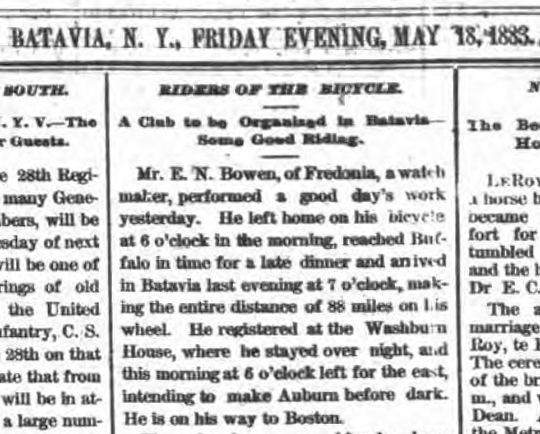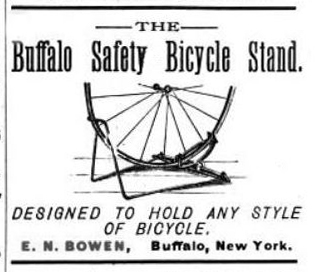An early view of St. James’ showing two faces of the tower clock
On the wall of the tower stairwell of St. James’ Episcopal Church, there is a framed note, neatly typed which reads as follows:
The Clock
E.N. Bowen Oct. 1, 1926
Some facts about the clock that interested me: The strike weights weigh about 625 pounds, all on. The strike weight falls 4 feet each day, 28 in the week, 42 coils on the drum, 126 turns of the crank, say 20 pounds, total 2520. Some job I say.
I add 8 coils for a margin of safety, so at the end of the week the weight will be 7 feet from the bottom of the shaft, with 18 coils on the drum, good for a 3 days run. The time drum holds 30 coils, 7 days uses 26 coils, leaving 4 for a margin of safety. I wind twice a week, dividing the work, to make it easier, and to watch the clock oftener.
There are 73 steps from the first floor, to the clock room, 2 are ladders of 17 steps each. This clock was made by the Howard Co. of Boston.
I am using Nye Tower Clock Oil, cost $1.00 an ounce, on the small bearings only, ordinary oil on the larger ones. The pendulum is 7 feet over all, the ball 9 inches, it beats 40 to a minute. Ball weight unknown.
The time cable, is one fourth inch, looks as if it [has] been in use since the start. The strike cable has been renewed, a larger one put on; it is too large for proper use on the drum, and piles up three layers of 26 coils each; they do not fit in the grooves and are uneven, snapping into place, with some wear on the wires.
I like the job! Have had many puzzling problems since the above date, they spur Me on to overcome them, and it is a pleasure to win, as I did this morning. The clock stopped two days back, a careful overlook did not find a cause, at that time; this morning I did locate it in the pendulum rod where the impulse pin slides in the slot; a tiny drop of oil fixed it; that was worth dollars to Me.
E.N. Bowen March 24, 1928

The note’s author, Ephraim Nutting Bowen, was paid $25 a year by the Village of Skaneateles to keep the timepiece in working order for the public. Born in Fitchburg, Massachusetts, in 1848, Ephraim was the son of Ephraim and Martha (Livermore) Bowen. In a 1931 letter to a granddaughter, he described his childhood, including his family’s three years in Australia during the gold rush, in terms of his education:
“My schooling was very limited, beginning at Fitchburg in the old Academy, and up to 7, then three years in Australia in a tent, an old English man showed me how to write and figure a bit, then in Boston at the Quincy School two years, then at a school in Roxbury, two years, then at Washington in the grammar school, three years, and there I quit and joined the Army. You can see my education was somewhat scattered.”
In Washington, D.C., Ephraim Sr. had a fruit store on Pennsylvania Avenue. In the early 1860s, young Ephraim Jr. liked to walk up the street to the White House whenever public receptions were held; he was an admirer of President Abraham Lincoln.
When Ephraim turned 16, he enlisted in the First Regiment U.S. Artillery. As the war neared its end, most of the First Regiment’s Batteries were stationed in and around the District of Columbia, so it is likely that the young man didn’t go far from home.
After the war, Ephraim returned to Fitchburg and married Almira Lucinda Bancroft; their daughter Helen May was born in Fitchburg in 1873. By 1876, they were living in Elgin, Illinois, where their son George was born. (I am guessing, but fairly sure, that Ephraim was working at the Elgin National Watch Company at this time.) In 1884, when Walter Bowen was born, the family was in Fredonia, N.Y., and Ephraim was making his way in the world with bicycles – selling, repairing and promoting them.
On September 20, 1882, while living in Fredonia, he cycled to Erie, Pennsylvania, and back, a total of 101 miles, which he covered in 13 hours, 30 minutes. In May of 1883, he rode to Boston, a distance of over 500 miles, in eight days, “three of which were wet.” The local paper in Batavia observed his passing through:

By 1890, E.N. Bowen had established a bicycle repair business on Main Street in Buffalo, N.Y., and was inventing new devices to improve them. His “Buffalo Safety Bicycle Stand” was patented in 1891.

A binder for handle bars and seat posts was patented by Bowen in 1900, and the patent assigned to George N. Pierce Co., a Buffalo manufacturer of bicycles (who later made the Pierce-Arrow automobile). A third patent was awarded Bowen in 1909, for transmission gearing, and assigned to Auto-Tri Manufacturing Co., a Buffalo company making a three-wheeled motorcycle.
In 1917, Ephraim’s son, George B. Bowen, came to Skaneateles and opened an automotive garage, taking over the business of the People’s Motor Sales Co. He had run a garage in Marcellus, N.Y., for three years, “with best of satisfaction and success, an unusual workman.” Clearly he had inherited his father’s knack for things mechanical.

Almira and Ephraim Bowen
In 1918, Ephraim Bowen sold his Buffalo bicycle business, and was semi-retired, listing his occupation as clock repair. He and Almira visited George in Skaneateles, and Almira was “so charmed by the cemetery” that she expressed a wish to be buried there. She died in 1922, and her wish was granted. Ephraim Bowen soon joined his son George in Skaneateles, and by 1925 was caring for the clock in St. James’ tower.
 Ephraim Bowen in his G.A.R. uniform
Ephraim Bowen in his G.A.R. uniform
He was a member of the Skaneateles post of the Grand Army of the Republic (the Civil War Union veterans’ equivalent of today’s American Legion).

In 1925, he built a new house for purple martins in Clift Park. The Audubon Society collected door-to-door to raise the funds for materials, and Bowen built the 36-room bird house, each room six inches square and seven inches high, made of cypress with an oak bottom and cedar roof. The community was grateful and I’m sure the birds were as well.
In June of 1931, he wrote to his granddaughter:
“My life now is a very happy one, I have time to dream, and build castles in the air, and it’s fun… this growing old has its drawbacks, but it is interesting, too. I feel so well, never a pain, body clean inside and out, mind a bit clouded at times, memory a rag, but eyes wide open to see the beautiful world around me.”
Ephraim Bowen died on February 9, 1936, and was buried on Lincoln’s birthday in Lake View Cemetery, next to his wife. The services were held in the Burrows Memorial Chapel, led by the Rev. Albert Fulton, pastor of the Skaneateles Presbyterian church.
* * *
The St. James’ tower clock has a story of its own: The clock is a memorial to Mr. & Mrs. John Legg; Mr. Legg was a blacksmith, carriage maker and businessman who prospered in the village. His son-in-law and daughter, Mr. & Mrs. Joel Thayer, donated the tower clock in memory of her parents on Christmas of 1873. The clock was made by E. Howard & Co. of Boston, Massachusetts, and installed in the just completed church building in January of 1874, with the assistance of machinist Howard Delano of Mottville. Other E. Howard clocks have graced the Clock Tower Building on Broadway in New York, the Ferry Building in San Francisco, the King Street Station in Seattle, and Chicago’s Wrigley Building.
The St. James’ clock has had some adventures along the way. On August 17, 1881, the local press noted:
“Last week the weight attached to the striking part of the town clock in St. James’ tower, weighing nine hundred pounds, and suspended by a quarter inch wire cable, fell, crashing through two floors. It was nearly wound up at the time, and fell a distance of sixteen feet before striking the first floor.”
In September of 1890, ‘The Rambler’ wrote in the Skaneateles Press:
“I hear complaint that the trees growing in front of the tower of the Episcopal church obscure the face of the town clock from passers-by. Inasmuch as the village pays for the care of the time-piece for the benefit of the public, the face of the clock should be exposed for the benefit of all.”
In 1892, the bell which struck the hours was found to be cracked, and was repaired. In 1898, the clock faces were repainted and the numbers re-gilded.
* * *
A few notes:
The Nye Tower Clock Oil that Bowen mentions was made from whale oil, and had a much finer viscosity than petroleum-based oils. It was ideal for small gears and bearings such as those in watches and clocks. The history of the company, which is still in business, is here: http://www.nyelubricants.com/history.shtml
George Bowen, the son of Ephraim Bowen, served as chairman of the greens committee at the Skaneateles Country Club, and has the distinction of being one of the few men, perhaps the only man, to ever hit a golf ball from the Country Club to the far shore of Skaneateles Lake. The long drive took place in 1945, and the ball was both hit and recovered in the presence of witnesses. Amazing, yes, but it was winter, and the presence of smooth, glare ice, upon which the ball bounced, skittered and slid to the eastern shore, helps to explain the feat.
I am especially grateful to the descendants of Ephraim Bowen for their generosity in sharing his photos and letters.




